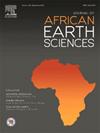Geology, fluid inclusions, sulfur isotopes, and Rare Earth Element signatures of the Ain Mimoun barite vein-type ore-deposit, Northeastern Algeria
IF 2.2
4区 地球科学
Q2 GEOSCIENCES, MULTIDISCIPLINARY
引用次数: 0
Abstract
The barite-vein type of Aïn Mimoun ore-deposit, located in the Saharan Atlas (North-eastern Algeria), is hosted in Albian-Aptian carbonates rocks, and controlled by NE-SW and E-W trending-faults. The vein mineralization mainly consists of barite, associated with galena, sphalerite, grey copper, chalcopyrite, and pyrite. Microthermometric analyses of fluid inclusions indicate moderate to high temperatures (∼105 °C–∼185 °C) and high salinities (20–25 % NaCl equiv.), with eutectic temperatures suggesting H2O-NaCl-CaCl2 brines. The presence of Na+ and Ca2+ in the solutions suggests interaction of the mineralizing fluids with the carbonate-hosted rocks and Triassic formations. The δ34S values of barite (15.7 ‰–26.6 ‰) indicate a sedimentary origin of sulfur, probably involving thermochemical sulfate reduction (TSR) processes. Two isotopic groups are distinguished: white barite associated with sulfides (15.7–17.4 ‰), reflecting sedimentary sulfates, and translucent barite (21.4–26.6 ‰), suggesting prolonged interaction with evaporites. Chondrite-normalized rare earth element (REE) spectra reveal an enrichment in light rare earth elements (LREE), negative cerium anomalies (Ce/La: 0.10–0.81), and positive europium anomalies (35.52–188.62 ppm; Eu/Eu∗: 54.71–88.14), characteristic of hydrothermal deposits created in oxidizing conditions.
These data suggest a hydrothermal epigenetic origin for the barite-vein type of Aïn Mimoun ore-deposit, classified as Mississippi Valley-Type (MVT). The mineralizing fluids were deep basinal brines migrating along fault zones, interacting with Cretaceous carbonate-hosted rocks and Triassic evaporites, contributing to the barite precipitation processes.
阿尔及利亚东北部Ain Mimoun重晶石脉型矿床地质、流体包裹体、硫同位素及稀土元素特征
Aïn Mimoun型重晶石脉型矿床位于阿尔及利亚东北部撒哈拉阿特拉斯地区,赋存于阿尔及利亚-阿普tian碳酸盐岩中,受NE-SW和E-W向断裂控制。脉状矿化以重晶石为主,伴生方铅矿、闪锌矿、灰铜、黄铜矿、黄铁矿。流体包裹体的显微温度分析表明,流体温度中至高温(~ 105°C ~ ~ 185°C),盐度高(20 - 25% NaCl当量),共晶温度表明是H2O-NaCl-CaCl2盐水。溶液中Na+和Ca2+的存在表明矿化流体与碳酸盐岩和三叠纪地层相互作用。重晶石的δ34S值(15.7‰~ 26.6‰)表明硫的沉积成因可能与热化学硫酸盐还原(TSR)作用有关。白色重晶石与硫化物(15.7 ~ 17.4‰)有关,反映沉积硫酸盐;半透明重晶石(21.4 ~ 26.6‰)与蒸发岩相互作用时间较长。球粒陨石归一化稀土元素(REE)光谱显示轻稀土元素(LREE)富集,负铈异常(Ce/La: 0.10 ~ 0.81),正铕异常(35.52 ~ 188.62 ppm);Eu/Eu *: 54.71-88.14),在氧化条件下形成的热液矿床的特征。这些资料表明Aïn Mimoun矿床为密西西比河谷型(MVT)重晶石脉型,具有热液表成成因。成矿流体为深盆盐水,沿断裂带迁移,与白垩系碳酸盐岩和三叠系蒸发岩相互作用,形成重晶石沉淀过程。
本文章由计算机程序翻译,如有差异,请以英文原文为准。
求助全文
约1分钟内获得全文
求助全文
来源期刊

Journal of African Earth Sciences
地学-地球科学综合
CiteScore
4.70
自引率
4.30%
发文量
240
审稿时长
12 months
期刊介绍:
The Journal of African Earth Sciences sees itself as the prime geological journal for all aspects of the Earth Sciences about the African plate. Papers dealing with peripheral areas are welcome if they demonstrate a tight link with Africa.
The Journal publishes high quality, peer-reviewed scientific papers. It is devoted primarily to research papers but short communications relating to new developments of broad interest, reviews and book reviews will also be considered. Papers must have international appeal and should present work of more regional than local significance and dealing with well identified and justified scientific questions. Specialised technical papers, analytical or exploration reports must be avoided. Papers on applied geology should preferably be linked to such core disciplines and must be addressed to a more general geoscientific audience.
 求助内容:
求助内容: 应助结果提醒方式:
应助结果提醒方式:


